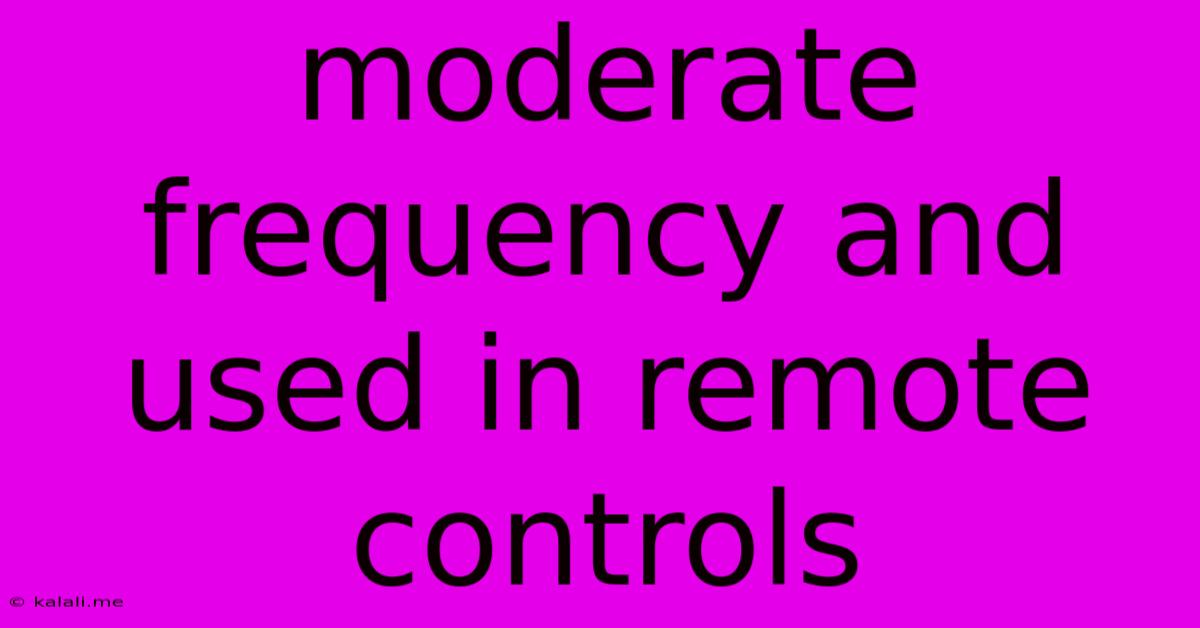Moderate Frequency And Used In Remote Controls
Kalali
Jun 13, 2025 · 3 min read

Table of Contents
Moderate Frequency: The Unsung Hero of Remote Control Technology
This article delves into the fascinating world of moderate frequencies and their crucial role in the ubiquitous technology we use every day: remote controls. We'll explore the specific frequency ranges employed, the reasons behind their selection, and the underlying technology that makes them so effective. Understanding these aspects helps appreciate the sophisticated engineering behind something we often take for granted.
Understanding Radio Frequency (RF) in Remote Controls
Remote controls utilize radio frequencies (RF) to transmit signals wirelessly. These signals, essentially coded instructions, travel through the air from the remote to the receiving device, be it a television, air conditioner, garage door opener, or countless other appliances. The specific frequency band employed is a key factor determining the range, reliability, and interference susceptibility of the remote control system. Moderate frequencies are particularly well-suited for this application.
The Sweet Spot: Why Moderate Frequencies are Ideal
While very high frequencies (VHF) and ultra-high frequencies (UHF) might seem like a better option for long-range communication, they present certain drawbacks in remote control applications. High frequencies are more prone to interference from other electronic devices, atmospheric conditions, and even physical obstacles. Conversely, very low frequencies (VLF) often lack the precision and bandwidth needed for complex commands.
Moderate frequencies strike a balance between these extremes. They offer a reasonable range sufficient for most household applications while maintaining relatively low susceptibility to interference. This sweet spot is crucial for reliable operation without excessive signal degradation. Common frequency ranges used include those around 300 MHz to 400 MHz, and others in the 2.4 GHz band, though these latter frequencies can sometimes be susceptible to WiFi interference. The specific frequency choice depends on regulatory compliance and the complexity of the communication protocol.
Key Advantages of Moderate Frequencies in Remote Control Design
- Lower Interference: Compared to higher frequency bands, moderate frequencies experience less interference from other sources, resulting in more reliable operation.
- Sufficient Range: The range offered is generally adequate for typical home usage scenarios. Longer ranges usually require more powerful transmitters and increased susceptibility to interference.
- Cost-Effectiveness: The technology required to generate and receive signals at moderate frequencies is relatively inexpensive, making it suitable for mass production of consumer electronics.
- Regulatory Compliance: These frequency bands are often allocated specifically for unlicensed or low-power devices, simplifying the regulatory process for manufacturers.
Modulation Techniques and Signal Encoding
The selection of moderate frequency isn't the only critical aspect. The way data is encoded and transmitted is equally important. Common modulation techniques used in remote control systems include amplitude-shift keying (ASK), frequency-shift keying (FSK), and pulse-position modulation (PPM). These techniques translate the button presses on the remote into specific electrical signals that are then transmitted at the chosen moderate frequency. The choice of modulation method impacts factors like data rate, power consumption, and resilience to noise.
The Future of Remote Control Frequencies
While moderate frequencies currently dominate the remote control landscape, technological advancements continuously shape the possibilities. The rise of smart home devices and Internet of Things (IoT) integration may see a shift towards more sophisticated communication protocols and frequency bands, potentially incorporating technologies such as Bluetooth Low Energy (BLE) and Zigbee. However, the advantages of moderate frequencies in terms of cost-effectiveness, reliability, and ease of implementation ensure they'll likely remain a significant player for the foreseeable future.
In conclusion, the seemingly mundane act of using a remote control relies on sophisticated technology. The strategic choice of moderate frequencies allows for a balance between range, reliability, and cost-effectiveness, underpinning the ubiquitous presence of remote controls in modern life. Understanding this fundamental aspect enhances our appreciation for the innovative engineering underlying this essential technology.
Latest Posts
Latest Posts
-
What Is Difference Between Pound And Kg
Jun 14, 2025
-
Which Phase Of Mitosis Is The Longest
Jun 14, 2025
-
Which Hormone Is Not Produced By The Placenta
Jun 14, 2025
-
The Electrons Present In The Outermost Shell Are Called
Jun 14, 2025
-
A Bar Magnet Is Placed In A Uniform Magnetic Field
Jun 14, 2025
Related Post
Thank you for visiting our website which covers about Moderate Frequency And Used In Remote Controls . We hope the information provided has been useful to you. Feel free to contact us if you have any questions or need further assistance. See you next time and don't miss to bookmark.